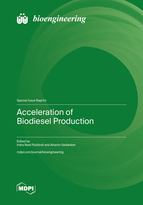Acceleration of Biodiesel Production
A special issue of Bioengineering (ISSN 2306-5354). This special issue belongs to the section "Biochemical Engineering".
Deadline for manuscript submissions: closed (30 September 2023) | Viewed by 38650
Special Issue Editors
Interests: energy sources; environmental science; materials science; catalysis; biofuels
Special Issues, Collections and Topics in MDPI journals
Special Issue Information
Dear Colleagues,
Undoubtedly, among various biofuels, biodiesel stands out as a sustainable and renewable transportation fuel with success in the market. Even though significant advances have been made in the realm of converting various biomass feedstock such as waste cooking oil and various non-edible feedstock such as micro algal lipids into biodiesel at an accelerated rate, much remains to be explored, as the energy needs are growing exponentially. At present, microwave-based technology is superior to any other known accelerated methods such as ultrasound or solar or microfluid reactors or mechanical stirring technologies. It is surprising to note that there are only 55 results in the Web of Science with the search keywords biodiesel and production and acceleration. Though the results from a Web of Science search are not a gospel truth, research in the realm of accelerated methods for biodiesel production is definitely only at the incipient stages, and much remains to be explored. For instance, there have been recent reports on using electrical field to accelerate biodiesel production. Likewise, thermal energy from nuclear reactors, magnetic field, electron beams, plasma irradiation, and unconventional radiation sources can be explored for the acceleration of biodiesel production, as the complexity of the raw materials is ever increasing as well. Interestingly, significant process has been made in the field of solid base catalysts, in that catalysts such as SrO, CaO, MgO, and activated-carbon-supported base catalysts have been used for the acceleration of biodiesel production. Thus, the objective of the current Special Issue titled “Acceleration of Biodiesel Production” is to enlarge the knowledge domain and to make available the know-how to the biorefiners and the methods for the fast production of biodiesel that ensure demand-based supply of product biodiesel in the market, leading to alleviation of humankind suffering due to energy poverty. Researchers in the field are enthusiastically encouraged to contribute their original results for publication in this Special Issue of the journal Bioengineering.
Dr. Indra Neel Pulidindi
Prof. Dr. Aharon Gedanken
Guest Editors
Manuscript Submission Information
Manuscripts should be submitted online at www.mdpi.com by registering and logging in to this website. Once you are registered, click here to go to the submission form. Manuscripts can be submitted until the deadline. All submissions that pass pre-check are peer-reviewed. Accepted papers will be published continuously in the journal (as soon as accepted) and will be listed together on the special issue website. Research articles, review articles as well as short communications are invited. For planned papers, a title and short abstract (about 100 words) can be sent to the Editorial Office for announcement on this website.
Submitted manuscripts should not have been published previously, nor be under consideration for publication elsewhere (except conference proceedings papers). All manuscripts are thoroughly refereed through a single-blind peer-review process. A guide for authors and other relevant information for submission of manuscripts is available on the Instructions for Authors page. Bioengineering is an international peer-reviewed open access monthly journal published by MDPI.
Please visit the Instructions for Authors page before submitting a manuscript. The Article Processing Charge (APC) for publication in this open access journal is 2700 CHF (Swiss Francs). Submitted papers should be well formatted and use good English. Authors may use MDPI's English editing service prior to publication or during author revisions.
Keywords
- biodiesel
- acceleration
- production
- microwave
- ultrasound
- solar energy
- mechanical stirring
- micro fluid reactor
- nuclear thermal energy
- electrodes
- electron beam
- electric field
- electro chemistry
- solid base
- catalyst
- biomass
- lipids, lipid culture








